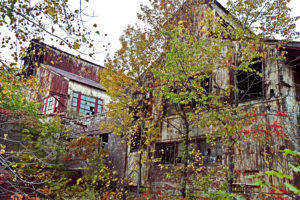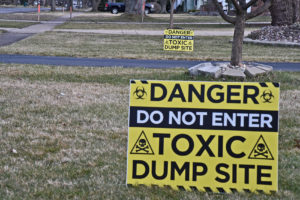Is America and the EPA ready to remediate our toxic industrial legacy?

Niagara Falls, North Tonawanda and Lockport helped build America through industry whose byproducts today still harm us and haunt us in the form of buried toxic waste.
Although many industrial waste sites have been remediated in Niagara County since Love Canal focused national attention here in the late 1970s, many more remain, including for instance, 20 known sites in the City of Lockport. (One of those is reported to be Simmonds Steel (above), which was involved in WWII’s Manhattan Project, and the radioactive hot spots there require water to be pumped continuously into the site.)
So perhaps America — through the EPA, which earlier this year already committed to a $12-million partial remediation of a contaminated site along the 18-Mile Creek watershed — is ready to take on the task of cleaning up the rest as the federal agency announced Wednesday a $300,000 grant to assess contaminated sites across Niagara County.
The award comes in two parts: $100,000 for petroleum contamination assessment and $200,000 for non-petroleum hazardous substances. It will allow the county to continue its own assessment program.
“In past years, our assessment program has led to real progress, turning contaminated sites back into economically viable parcels,” said County Legislator Kathryn Lance. “Some examples include the Remington Rand site in North Tonawanda, the South Junior High School in Niagara Falls that is being converted into apartments, and the Washington Hunt Elementary School in Lockport, which is being reborn as a gym.”
The $300,000 funding request was developed by Brownfields Development Corp. President Amy Fisk, a senior planner at the county’s Center for Economic Development. Lance and Fisk said the county placed an emphasis on assessing tax-delinquent parcels. This includes both Phase I and Phase II Environmental Site Assessments, which range from review of paperwork and database information to on-site sampling and testing.
“Determining the level of contamination will allow these properties to be remediated and returned to productive use, returning them to the tax rolls and allowing the private sector to create jobs there,” Lance said. “Cleaning up and reinvesting in these properties protects the environment, reduces blight, and takes development pressures off greenspaces and working lands. Ultimately, we want to bring these parcels back to life.”
The health cost to Niagara County residents is even higher, however. And as the contamination spreads and travels through ground water channels, it continues to affect people’s health.

Residents in Wheatfield have been fighting to draw attention to an industrial waste dump that’s hurting their health. The DEC is currently testing areas around the site as well as residents’ homes.






































